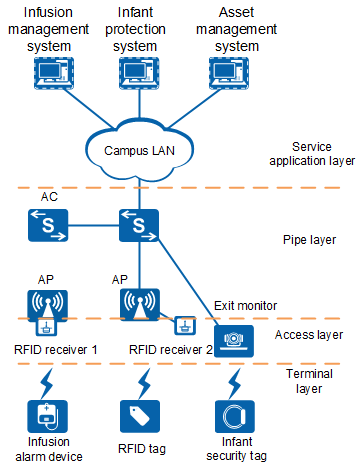Overview of the Healthcare IoT Solution
Scenario Overview
In healthcare scenarios, hospitals want to use technology means to implement infusion management and infant abduction prevention to avoid major medical malpractice and security accidents, improving hospitals' management capabilities and patient satisfaction.
Additionally, hospitals need to manage important medical assets. Manual asset management and inventory are time-consuming, expensive, and difficult to locate assets. Hospitals also want to leverage technology means for asset location and management to reduce management costs and complexity.
To meet the requirements in such scenarios, Huawei offers the Smart Healthcare - Healthcare IoT Solution to add people and things to the Internet of Things (IoT), implementing infant abduction prevention, infusion management, and medical asset management.
Solution Benefits
The Healthcare IoT Solution brings benefits to customers based on the following advantages:
- Uses technology means to prevent major medical malpractice and security accidents, improving hospitals' management capabilities and patient satisfaction.
- Uses technology means for asset location and management to monitor medical assets, prevent asset loss, and save labor costs.
- Reuses a WLAN as a healthcare IoT, reducing the healthcare IoT deployment and maintenance costs, and facilitating central network management by administrators.
Networking Architecture
As shown in Figure 1, the networking architecture of the Healthcare IoT Solution consists of the terminal, access, pipe, and service application layers.
Terminal layer
Infusion alarm devices, radio frequency identification (RFID) tags, and infant security tags are deployed at this layer and used for infusion management, asset management, and infant abduction prevention scenarios.
Access layer
RFID receivers and exit monitors are deployed at this layer. RFID receivers can be embedded in APs as built-in cards, such as RFID receiver 1 in the preceding figure. They can also be inserted into USB ports of APs as external USB modules or connected to APs through USB extension cables, such as RFID receiver 2 in the preceding figure.
Pipe layer
Network devices such as APs, ACs, and switches are deployed at this layer. The pipe layer is used only for forwarding packets of healthcare IoT devices.
Service application layer
Platform systems such as the infusion management system, infant protection system, and asset management system are deployed at this layer. These systems can be deployed on either the same server or different servers.
Involved Products
Device |
Function |
Vendor |
|---|---|---|
AP |
It provides a slot or USB port for an RFID receiver. RFID receivers connect to a WLAN through APs. |
Huawei Only the AP2050DN, AP2050DN-E, AP2050DN-S, AP2051DN, AP2051DN-E, AP2051DN-S, AP4030TN, AP4050DN-E, AP4051DN, AP4051DN-S, AP4051TN, AP4151DN, AP5050DN-S, AP6050DN, AP6052DN, AP6150DN, AP7050DE, AP7050DN-E, AP7052DE, AP7052DN, WA375DD-CE, AP7060DN, AirEngine 5760-10, AP7152DN, R250D-E, and R251D-E can be used. Among them, the AP4050DN-E, AP7052DN, AP7060DN, and AP7152DN can connect to RFID receivers through card slots or USB ports, while the other APs can connect to RFID receivers only through USB ports. |
AC |
It manages and delivers configurations to APs, and works together with the APs. |
Huawei |
| Switch | It is used to build a networking structure and forward packet data on the network. |
Huawei |
Infusion alarm device |
It detects the infusion status of patients, and sends information to the host computer at the nurse workstation. When detecting infusion completion, the infusion alarm device stops infusing fluids while reporting an alarm. |
Enjoyor |
Handheld digital terminal |
It is used to scan barcodes on fluid bags and patient wristbands, and send information to a host computer. The host computer associates patients with fluid bags. |
Enjoyor |
Barcode printer |
It is used to print barcodes that are pasted on fluid bags or bottles for identification. |
Enjoyor |
Wireless calling unit |
It is used by patients for calling nurses. |
Enjoyor |
Infant security tag |
It is an electronic security tag used for exchanging data with exit monitors and RFID receivers, and sending information such as exit monitor IDs to RFID receivers. |
Enjoyor |
RFID receiver |
It can be embedded in an AP as a built-in card, or connected to an AP through the USB port as an external USB module. |
Enjoyor |
Exit monitor |
It is used for precisely locating infants to prevent infant abductions. |
Enjoyor |
Audible and visual alarm device |
It sends audible and visual alarms if exit monitors detect alarm events in a geo-fence. |
Enjoyor |
Electronic wrist strap |
It is a wrist trap working with infant security tags, and has no harm to infant skin. |
Enjoyor |
Infusion management system |
It manages infusion processes efficiently to ensure infusion security. |
Enjoyor |
Infant protection system |
It monitors and manages operation of the entire system. |
Enjoyor |
Asset management system |
It monitors and manages operation of the entire system. |
Enjoyor |
